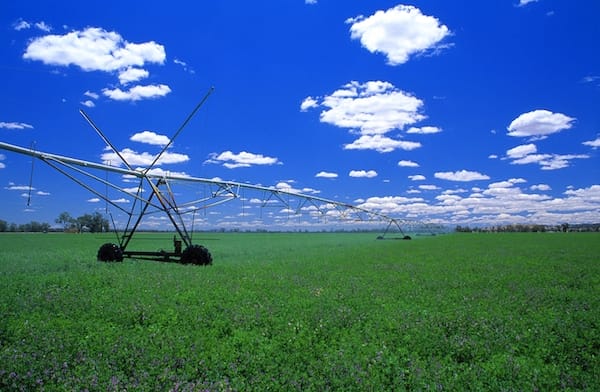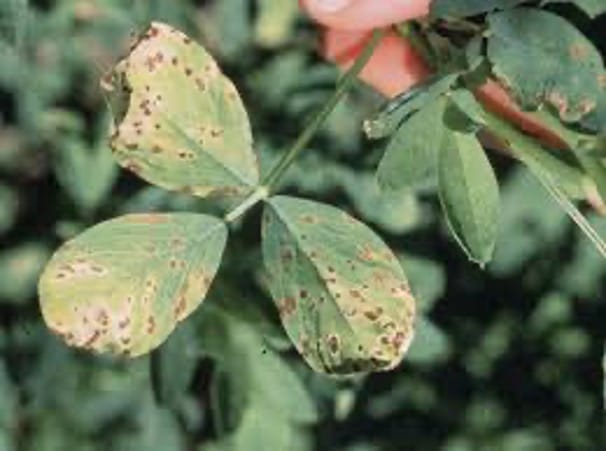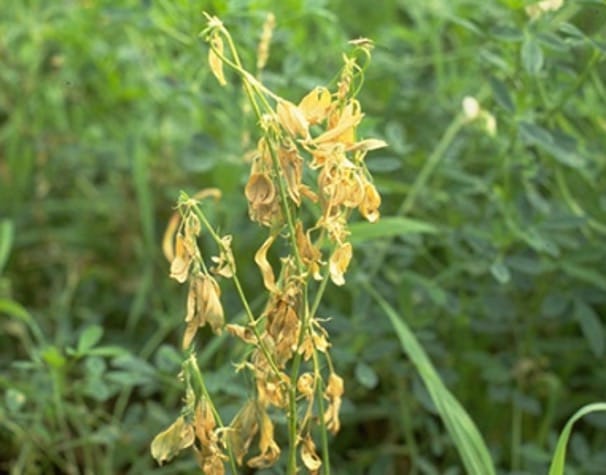If you are a progressive farmer and manage a lucerne pasture, you should read this article. It talks about some of the important diseases that can affect your pasture and reduce your yields. You may want to check out this article here on weed control methods, otherwise, please see the following on lucerne:
Advantages of a lucerne pasture
What causes diseases in lucerne
Common bacterial and viral diseases that affect lucerne pastures
Common fungal diseases that affect lucerne pastures
Managing a healthy lucerne pasture

Advantages of a lucerne pasture
Lucerne, also known as alfalfa, is a high quality, protein rich fodder crop. It can be grown in both rain fed as well as irrigated conditions.
It is one of the highest yielding forage legumes and can produce up to 25 tons of dry matter per hectare under optimal irrigated conditions. It can also be used as pasture, hay and silage.
Lucerne is a high quality, protein rich fodder crop that can produce yields up to 25 tons per hectare.
What causes diseases in lucerne
However, lucerne is also susceptible to a few diseases are caused by bacteria, fungi, and viruses.
Viruses are among the tiniest organisms. They do not have any cells and depends on other organisms for survival. Bacteria are unicellular organisms. Fungi are slightly bigger, and more complex organisms.
The vast majority of these microscopic organisms are harmless. But some of them harm your lucerne pasture. Let’s find out more about these harmful ones.
Common fungal diseases that affect lucerne pastures
1. Common leaf spot
2. Pepper spot
3. Rust
4. Spring black stem
5. Sclerotinia crown and stem rot
Lucerne diseases such as leaf spot (left) and bacterial wilt (right) cause significant yield losses. Picture Source: plantpathology.ca.uky.edu/files/ppfs-ag-f-09.pdf
1. Common leaf spot
Common leaf spot is caused by the fungus Pseudopeziza medicaginis. As the name suggests, it is a common disease of pasture legumes, occurring in late autumn and winter.
The disease does not kill plants, and rarely causes serious economic losses. When severe however, plants can be defoliated, reducing hay quality and yield.
Round, dark spots occur across the upper leaf surface. Infected leaves turn yellow, then brown and finally wither to the ground. Elongated spots can also occur on the affected stems.
The fungus carries over on infected plant debris on the soil surface. Infected crop debris and spores can propagate via wind over short distances.
2. Pepper spot
Pepper spot is caused by the fungus Leptosphaerulina trifolii. It is quite similar to the common leaf spot disease and occurs in lucerne between late autumn and early spring, as it prefers cool moist weather conditions.
It usually does not cause serious herbage losses. However, when severe, this disease can reduce both yield and quality, especially crude protein content.
Affected plants develop round, dark spots on the leaves, stems and runners. The spots are usually confined to the upper leaf surface, and may be so numerous that the leaves appear covered in soot. Severe infections can cause the leaves to cup, turn brown and die prematurely.
Both infected plant debris and seed can further propagate this disease.
3. Rust
Rust is caused by the fungus Uromyces striatus. It is a very common disease of lucerne. Severe outbreaks can cause significant yield quantity and quality losses because of defoliation.
Affected plants have reddish-brown pustules under the leaves and on stems. When severe, leaves wilt and fall prematurely. Choosing rust tolerant cultivars are your best option to control rust.
4. Spring black stem
This is a common disease of lucerne which can cause reductions in yield and forage quality. It is caused by the fungus Phoma medicaginis.
Affected plants rapidly develop lesions on the stems. This continues until most of the stem is blackened. Severely infected stems wither and die. The leaves also turn yellow and wilt.
There aren’t any resistant cultivars or chemicals. Seed from drier regions are less likely to be infected. When affected, you could cut hay as early as possible to reduce losses through leaf drop.
5. Sclerotinia crown and stem rot
This is caused by the fungus Sclerotinia trifoliorum. It occurs in most lucerne growing areas. The greatest damage occurs when seedlings are affected.
The fungus infects the base of the stems, near the soil line, and causes rapid wilting. A white cottony fungal mold may develop on the infected tissue during moist weather.
Like other fungal diseases, this also becomes dormant and develops into small, hard, black sclerotia. This can stay viable for many years and can be propagated to other areas through wind and water.
There are no resistant cultivars. Your best options are to use sclerotia free seed and to closely graze the crop in autumn to reduce humidity within the stand.

Managing a healthy lucerne pasture
In general, bacterial and viral diseases can be reduced by selecting good seed and resistant cultivars. On the other hand, fungal diseases can be limited by reducing humidity and excess moisture.
By closely grazing lucerne paddocks during autumn, you can reduce humidity in lucerne stands. Also, spores of several infectious fungi can spread via droplets of water on cutting equipment. So a good practice is to cut only completely dry foliage. This will reduce the spread of pathogens.
Most pathogens also don’t survive well in the absence of a host plant. So practicing crop rotations every three to five years will ensure good soil health as well as reduce incidences of disease. Corn, small grains, soybeans, and forage grasses are good rotation crops that can help reduce lucerne pathogens.
Several root rot fungi that affect Lucerne are most active in poorly drained soils. So choosing a well-drained site to grow lucerne may also help reduce root rot diseases to a large extent.
In case of a fungal disease outbreak, the fungi can survive for up to five years in a dormant state known as sclerotia. Only deep ploughing can help you bury the sclerotia and reduce chances of a re-infestation.
Good irrigation management will also help you maintain optimal growing conditions that prevent disease attacks and maintain healthy soil. It can help you prevent both water logging and dry conditions.
This brings us to the end of this article. I hope you found it useful. If so please do share this with other farmers you know. If you have any questions, please let me know. I promise to answer them for you in the comments below.
Thanks for reading and until we meet in another article, happy farming!
- The Dedicated Team of Pasture.io, 2020-03-04


